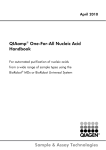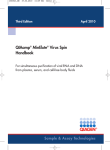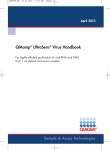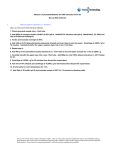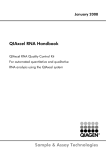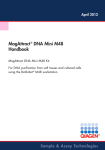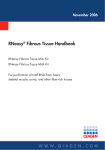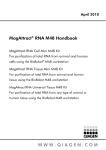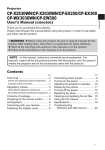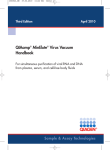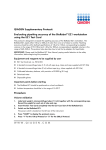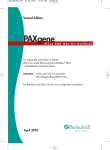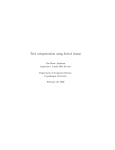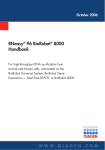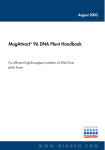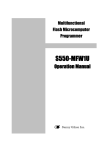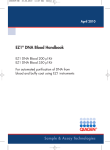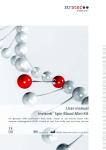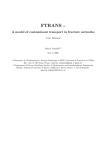Download MagAttract Viral RNA M48 Handbook
Transcript
1063013-HB 26.04.2010 12:44 Uhr Seite 1 Second Edition April 2010 MagAttract® Viral RNA M48 Handbook For purification of viral RNA from serum and plasma using the BioRobot® M48 workstation W W W. Q I A G E N . C O M 1063013-HB 26.04.2010 12:44 Uhr Seite 2 Trademarks: QIAGEN®, BioRobot®, MagAttract® (QIAGEN Group); Microsoft®, Windows® (Microsoft Corporation). The PCR process is covered by the foreign counterparts of U. S. Patents Nos. 4,683,202 and 4,683,195 owned by F. Hoffmann-La Roche Ltd. © 2003–2010 QIAGEN, all rights reserved. QIAGEN is a member of the Forest Stewardship Council (FSC). For the production of printed materials, including handbooks, QIAGEN has a policy to select suppliers that comply with FSC standards for printing processes and well-managed forests. 1063013-HB 26.04.2010 12:44 Uhr Seite 3 Contents Kit Contents 4 Storage 4 Quality Control 4 Product Use Limitations 4 Product Warranty and Satisfaction Guarantee 5 Technical Assistance 5 Safety Information 6 Introduction 7 Principle and procedure 7 Equipment and Reagents to Be Supplied by User 8 Important Notes 9 Preparing serum and plasma samples 9 Yields of viral RNA 9 Storing viral RNA 9 Protocol Purification of Viral RNA from Serum or Plasma 10 Troubleshooting Guide 12 Appendix: General Remarks on Handling RNA 14 Ordering Information 16 QIAGEN Distributors 19 MagAttract Viral RNA M48 Handbook 04/2010 3 1063013-HB 26.04.2010 12:44 Uhr Seite 4 Kit Contents MagAttract Viral RNA M48 Kit Catalog no. Number of preps MagAttract Suspension F Buffer MFL (96) 955235 96 10 ml 77 ml Buffer MFW1 2 x 77 ml Buffer MFW2 2 x 100 ml Buffer MFE 10 ml Handbook 1 Storage All buffers and reagents should be stored at 2–8°C. Do not freeze MagAttract Suspension F. Quality Control In accordance with QIAGEN’s ISO-certified Quality Management System, each lot of MagAttract Viral RNA M48 Kits is tested against predetermined specifications to ensure consistent product quality. Product Use Limitations The MagAttract Viral RNA M48 Kit is intended for molecular biology applications. This product is not intended for the diagnosis, prevention, or treatment of a disease. All due care and attention should be exercised in the handling of the products. We recommend all users of QIAGEN® products to adhere to the NIH guidelines that have been developed for recombinant DNA experiments, or to other applicable guidelines. 4 MagAttract Viral RNA M48 Handbook 04/2010 1063013-HB 26.04.2010 12:44 Uhr Seite 5 Product Warranty and Satisfaction Guarantee QIAGEN guarantees the performance of all products in the manner described in our product literature. The purchaser must determine the suitability of the product for its particular use. Should any product fail to perform satisfactorily due to any reason other than misuse, QIAGEN will replace it free of charge or refund the purchase price. We reserve the right to change, alter, or modify any product to enhance its performance and design. If a QIAGEN product does not meet your expectations, simply call your local Technical Service Department or distributor. We will credit your account or exchange the product — as you wish. Separate conditions apply to QIAGEN scientific instruments, service products, and to products shipped on dry ice. Please inquire for more information. A copy of QIAGEN terms and conditions can be obtained on request, and is also provided on the back of our invoices. If you have questions about product specifications or performance, please call QIAGEN Technical Services or your local distributor (see back cover). Technical Assistance At QIAGEN we pride ourselves on the quality and availability of our technical support. Our Technical Service Departments are staffed by experienced scientists with extensive practical and theoretical expertise in molecular biology and the use of QIAGEN products. If you have any questions or experience any difficulties regarding the MagAttract Viral RNA M48 Kit or QIAGEN products in general, please do not hesitate to contact us. QIAGEN customers are a major source of information regarding advanced or specialized uses of our products. This information is helpful to other scientists as well as to the researchers at QIAGEN. We therefore encourage you to contact us if you have any suggestions about product performance or new applications and techniques. For technical assistance and more information please call one of the QIAGEN Technical Service Departments or local distributors (see back cover). MagAttract Viral RNA M48 Handbook 04/2010 5 1063013-HB 26.04.2010 12:44 Uhr Seite 6 Safety Information When working with chemicals, always wear a suitable lab coat, disposable gloves, and protective goggles. For more information, please consult the appropriate material safety data sheets (MSDSs). These are available online in convenient and compact PDF format at www.qiagen.com/ts/msds.asp where you can find, view, and print the MSDS for each QIAGEN kit and kit component. CAUTION: DO NOT add bleach or acidic solutions directly to the sample-preparation waste. Buffers MFL and MFW1 contain guanidine hydrochloride or guanidine thiocyanate, which can form highly reactive compounds when combined with bleach. If liquid containing these buffers is spilt, clean with suitable laboratory detergent and water. If the spilt liquid contains potentially infectious agents, clean the affected area first with laboratory detergent and water, and then with 1% (v/v) sodium hypochlorite. If liquid containing potentially infectious agents is spilt on the BioRobot M48, clean the affected area first with laboratory detergent and water, and then with 1% (v/v) sodium hypochlorite, followed by water. The following risk and safety phrases apply to the components of the MagAttract Viral RNA M48 Kit: Buffer MFL Contains guanidine thiocyanate: harmful. Risk and safety phrases:* R20/21/22-32, S13-26-36-46 Buffer MFW1 Contains guanidine hydrochloride: harmful, irritant. Risk and safety phrases:* R22-36/38, S13-26-36-46 24-hour emergency information Emergency medical information in English, French, and German can be obtained 24 hours a day from: Poison Information Center Mainz, Germany Tel: +49-6131-19240 * R20/21/22: Harmful by inhalation, in contact with skin and if swallowed; R22: Harmful if swallowed; R32: Contact with acids liberates very toxic gas; R36/38: Irritating to eyes and skin; S13: Keep away from food, drink, and animal feedingstuffs; S26: In case of contact with eyes, rinse immediately with plenty of water and seek medical advice; S36: Wear suitable protective clothing; S46: If swallowed, seek medical advice 6 MagAttract Viral RNA M48 Handbook 04/2010 1063013-HB 26.04.2010 12:44 Uhr Seite 7 Introduction The MagAttract Viral RNA M48 Kit provides fully automated purification of viral RNA from serum and plasma. MagAttract technology provides high-quality RNA, which is suitable for direct use in downstream applications, such as amplification or other enzymatic reactions. The BioRobot M48 performs all steps of the sample preparation procedure. Up to 48 samples, in multiples of 6, are processed in a single run. Principle and procedure MagAttract technology combines the speed and efficiency of silica-based RNA purification with the convenient handling of magnetic particles. Viral RNA binds to the silica surface of the magnetic particles in the presence of a chaotropic salt (see flowchart below). Viral RNA bound to the magnetic particles is then efficiently washed using two different wash buffers. High-quality viral RNA is eluted at 65°C in an RNase-free elution buffer. The MagAttract Viral RNA M48 Procedure Serum or blood plasma Lyse with Buffer MFL MagAttract Suspension F added to samples RNA binds to magnetic particles Magnet Magnetic separation Wash with Buffer MFW1, then with Buffer MFW2 Magnet Magnetic separation Elute with Buffer MFE Pure, high-quality viral RNA MagAttract Viral RNA M48 Handbook 04/2010 7 1063013-HB 26.04.2010 12:44 Uhr Seite 8 Equipment and Reagents to Be Supplied by User When working with chemicals, always wear a suitable lab coat, disposable gloves, and protective goggles. For more information, consult the appropriate material safety data sheets (MSDSs), available from the product supplier. ■ BioRobot M48 workstation (cat. no. 9000708) ■ App. Package, M48, Inf. Dis. (cat. no. 9016145) ■ Filter-Tips, 1000 µl, M48 (1000), cat. no. 995652 ■ Reagent Containers, small, M48 (100), cat. no. 995902 ■ Reagent Containers, large, M48 (50), cat. no. 995904 ■ Reagent Container Seals, M48 (50), cat. no. 995906 ■ Sample Prep Plates, 42-well, M48 (100), cat. no. 995908 ■ Cooling Block, 48-tube, 0.2 ml, M48, cat. no. 9015178* ■ Sample tubes, 1.5 ml, without lids (Sarstedt, cat. no. 72.696)† or with screw caps (Sarstedt, cat. no. 72.692)† ■ Tubes for cooling block, 1.5 ml, without lids (Sarstedt, cat. no. 72.696)† ■ Elution tubes with screw caps, 1.5 ml (Sarstedt, cat. no. 72.692)† or 2 ml (Sarstedt, cat. no. 72.693)† ■ PCR tubes, 0.2 ml, thin-walled* ■ Sterile, RNase-free pipet tips ■ Optional: 14.3 M β-mercaptoethanol (β-ME)‡ (commercially available solutions are usually 14.3 M) * Required if eluting viral RNA into 0.2 ml tubes. † This is not a complete list of suppliers and does not include many important vendors of biological supplies; however, use of other tubes may result in an instrument crash. ‡ The addition of β-ME to Buffer MFL will slightly improve the yield and quality of viral RNA. Dispense in a fume hood and wear appropriate protective clothing. Add 10 µl of β-ME per 1 ml of Buffer MFL just before use. Discard unused solution at the end of the day. 8 MagAttract Viral RNA M48 Handbook 04/2010 1063013-HB 26.04.2010 12:44 Uhr Seite 9 Important Notes Preparing serum and plasma samples The purification procedure is optimized for use with 300 µl serum or plasma samples. Blood samples treated with EDTA or citrate as anticoagulant can be used for plasma preparation. Samples can be either fresh or frozen, provided that they have not been frozen and thawed more than once. After collection and centrifugation, plasma or serum can be stored at 2–8°C for up to 6 hours. For longer storage, we recommend freezing aliquots at –20°C or –80°C. Frozen plasma or serum must not be thawed more than once. Repeated freeze–thawing leads to denaturation and precipitation of proteins, resulting in reduced viral titers and therefore reduced yields of viral RNA. If cryoprecipitates are visible in the samples, centrifuge at 6800 x g for 3 minutes, transfer the supernatants to fresh tubes without disturbing the pellets, and start the purification procedure immediately. Removing cryoprecipitates does not reduce viral titers. Yields of viral RNA The yield of purified viral RNA depends on the sample type and virus titer. Using this kit, the yield of viral RNA per sample is normally below 1 µg and is therefore difficult to determine with a spectrophotometer. Quantitative amplification methods are recommended for determination of yields. The size distribution of viral RNA purified with this procedure can be checked by agarose gel electrophoresis and hybridization to a virus-specific labeled probe followed by autoradiography (Sambrook, J., Russell, D.W., eds. [2001] Molecular Cloning: A Laboratory Manual, 3rd ed. Cold Spring Harbor Laboratory Press). Storing viral RNA For short-term storage of up to 24 hours, we recommend storing the purified viral RNA at 2–8°C. For long-term storage of over 24 hours, we recommend storage at –20°C to –70°C. MagAttract Viral RNA M48 Handbook 04/2010 9 1063013-HB 26.04.2010 12:44 Uhr Seite 10 Protocol: Purification of Viral RNA from Serum or Plasma Protocol Important points before starting ■ If working with RNA for the first time, read the appendix (page 14). ■ Ensure that you are familiar with operating the BioRobot M48 workstation. Refer to the BioRobot M48 User Manual for operating instructions. ■ The purified viral RNA can be eluted in 50 µl, 65 µl, 80 µl, or 100 µl elution buffer (Buffer MFE). Elution in smaller volumes increases the final RNA concentration in the eluate, but slightly reduces overall RNA yield. We recommend using an elution volume appropriate for the intended downstream application. ■ This protocol purifies both RNA and DNA. Use RNase-free DNase to remove DNA if performing sensitive downstream applications. ■ At the end of a protocol run, residual reagents should either be removed immediately from the workstation and transferred to an airtight container for later use, or discarded. Things to do before starting ■ Optional: The addition of β-mercaptoethanol (β-ME) to Buffer MFL will slightly improve the yield and quality of viral RNA. Add 10 µl β-ME per 1 ml Buffer MFL just before use. Dispense in a fume hood and wear appropriate protective clothing. Buffer MFL is stable at 4°C for 3 months after opening. After addition of β-ME to an aliquot of Buffer MFL, the solution must be used up on the same day. Procedure 1. Distribute 300 µl of serum or plasma into 1.5 ml sample tubes. Proceed to step 2 immediately, or freeze the samples and store at –70°C for long-term storage. If using frozen samples, thaw at room temperature (15–20°C) and mix well by inverting sample tubes before proceeding to step 2. See “Preparing serum and plasma samples” on page 9. Note: Avoid repeated freezing and thawing of the samples and do not store the samples for more than 6 h at 2–8°C, otherwise aggregation of magnetic particles may occur during the purification procedure, leading to reduced viral RNA yields. 2. Switch on the BioRobot M48. The power switch is on the left side of the instrument. 3. 10 Switch on the computer and monitor. MagAttract Viral RNA M48 Handbook 04/2010 1063013-HB 4. 26.04.2010 12:44 Uhr Seite 11 Launch the QIAsoft M Operating System. Upon startup, the computer displays the QIAsoft M startup window. Click “Start“ to continue. 5. Select the protocol group “Infectious Disease” from the drop-down menu, by clicking the dark green arrow, then select “Viral NA”. 6. Select the protocol “Viral RNA” and click the “Select” button to choose the type of elution tube. Input the number of samples and sample and elution volumes into the software. The QIAsoft M software will now guide you through the remaining steps required to set up the BioRobot M48 for the protocol selected; these steps include the option of entering names for your samples. Be sure to follow all instructions that appear. Wear gloves when loading the required items on the worktable. Note: Ensure that the appropriate cooling block is installed at the “Heat/Cool Block 2” slot of the worktable. For details, refer to the BioRobot M48 User Manual. 7. Close the workstation door and start the protocol when instructed by the software. All subsequent steps are automated. The software displays a table of results when the protocol is finished. 8. Retrieve the elution tubes containing the purified viral RNA from the cooling block. The viral RNA is ready to use, or can be stored at 2–8°C for a few hours or at –20°C to –70°C for long-term storge. Carryover of magnetic particles in eluates will not affect most downstream applications, including RT-PCR. If the risk of magnetic-particle carryover needs to be minimized (e.g., for applications such as real-time PCR), the elution tubes containing eluate should first be applied to a suitable magnetic separator (e.g., QIAGEN 12-Tube Magnet, cat. no. 36912, for 1 min) and the eluates transferred to clean tubes. If a suitable magnetic separator is not available, centrifuge the tube containing the RNA for 1 min at full speed in a microcentrifuge to pellet any remaining magnetic particles. MagAttract Viral RNA M48 Handbook 04/2010 11 Protocol If the QIAsoft M startup window does not appear, either double-click the QIAsoft M icon on the desktop or click the Microsoft® Windows® “Start” menu and select QIAsoft M Operating System → QIAsoft M V2.0 for BioRobot M48. 1063013-HB 26.04.2010 12:44 Uhr Seite 12 Troubleshooting Guide This troubleshooting guide may be helpful in solving any problems that may arise. The scientists in QIAGEN Technical Services are always happy to answer any questions you may have about either the information and protocol in this handbook or molecular biology applications (see back cover for contact information). Comments and suggestions Software error QIAsoft M software error dialog box If the QIAsoft M software displays an error dialog box during a protocol run, refer to the Troubleshooting Guide in the BioRobot M48 User Manual. Low viral RNA yield a) MagAttract Suspension F Before starting the procedure, ensure that MagAttract was not completely Suspension F is fully resuspended. Vortex for at least resuspended 3 min before first use, and for 1 min before subsequent uses. b) Reagents were loaded onto worktable in wrong order Ensure that all reagents are loaded onto the worktable in the correct order. Repeat the purification procedure with new samples. c) RNA degraded RNA may have been degraded by RNases in the original plasma or serum samples. Ensure that the samples are processed immediately after collection or removal from storages. Although all buffers have been tested and are guaranteed RNase-free, RNases can be introduced during use. Take care not to introduce any RNases during the purification procedure or later handling (see appendix, page 14). Use Buffer MFE for RNA elution. d) 12 RNase contamination in Buffer MFE If opening and closing a Buffer MFE vial many times, take care not to introduce RNases. In case of RNase contamination, replace the contaminated vial with a new Buffer MFE vial. Repeat the purification procedure with new samples. MagAttract Viral RNA M48 Handbook 04/2010 1063013-HB 26.04.2010 12:44 Uhr Seite 13 Comments and suggestions Viral RNA does not perform well in downstream enzymatic reactions a) Little or no RNA in the eluate See “Low viral RNA yield” (page 12) for possible reasons. Increase the amount of eluate added to the reaction, if possible. b) Frozen serum or plasma samples not mixed properly after thawing Thaw frozen samples at room temperature (15–25°C) and mix by pulse vortexing for 15 s. c) RNA in samples already degraded prior to purification Samples were frozen and thawed more than once or stored at room temperature for too long. Always use fresh samples or samples thawed only once (see “Preparing serum and plasma samples”, page 9). Repeat the purification procedure with new samples. d) Too much eluate in the amplification reaction Determine the maximum volume of eluate suitable for your amplification reaction. Reduce or increase the volume of eluate added to the amplification reaction accordingly. e) Carryover of magnetic particles Carryover of magnetic particles in the eluates will not affect most downstream applications, including RT-PCR. If the risk of magnetic-particle carryover needs to be minimized (e.g., for applications such as real-time RTPCR), first place the tubes containing eluate in a suitable magnet (e.g., 12-Tube Magnet, cat. no. 36912) for 1 min, and then transfer the eluates to clean tubes. If a suitable magnet is not available, centrifuge the tubes containing eluates in a microcentrifuge at full speed for 1 min to pellet any remaining magnetic particles, and transfer the supernatants to clean tubes. MagAttract Viral RNA M48 Handbook 04/2010 13 1063013-HB 26.04.2010 12:44 Uhr Seite 14 Appendix: General Remarks on Handling RNA Handling RNA Ribonucleases (RNases) are very stable and active enzymes that generally do not require cofactors to function. Since RNases are difficult to inactivate and even minute amounts are sufficient to destroy RNA, do not use any plasticware or glassware without first eliminating possible RNase contamination. Great care should be taken to avoid inadvertently introducing RNases into the RNA sample during or after the isolation procedure. In order to create and maintain an RNase-free environment, the following precautions must be taken during pretreatment and use of disposable and non-disposable vessels and solutions while working with RNA. General handling Proper microbiological, aseptic technique should always be used when working with RNA. Hands and dust particles may carry bacteria and molds and are the most common sources of RNase contamination. Always wear latex or vinyl gloves while handling reagents and RNA samples to prevent RNase contamination from the surface of the skin or from dusty laboratory equipment. Change gloves frequently and keep tubes closed whenever possible. Keep isolated RNA on ice when aliquots are pipetted for downstream applications. Disposable plasticware The use of sterile, disposable polypropylene tubes is recommended throughout the procedure. These tubes are generally RNase-free and do not require pretreatment to inactivate RNases. Non-disposable plasticware Non-disposable plasticware should be treated before use to ensure that it is RNase-free. Plasticware should be thoroughly rinsed with 0.1 M NaOH,* 1 mM EDTA* followed by RNase-free water (see ”Solutions”, page 15). Alternatively, chloroform-resistant plasticware can be rinsed with chloroform* to inactivate RNases. Glassware Glassware should be treated before use to ensure that it is RNase-free. Glassware used for RNA work should be cleaned with a detergent,* thoroughly rinsed, and oven baked at 240°C for four or more hours (overnight, if more convenient) before use. Autoclaving * When working with chemicals, always wear a suitable lab coat, disposable gloves, and protective goggles. For more information, consult the appropriate material safety data sheets (MSDSs), available from the product supplier. 14 MagAttract Viral RNA M48 Handbook 04/2010 1063013-HB 26.04.2010 12:44 Uhr Seite 15 alone will not fully inactivate many RNases. Alternatively, glassware can be treated with DEPC* (diethyl pyrocarbonate). Fill glassware with 0.1% DEPC (0.1% in water), allow to stand overnight (12 hours) at 37°C, and then autoclave or heat to 100°C for 15 minutes to eliminate residual DEPC. Electrophoresis tanks Electrophoresis tanks should be cleaned with detergent solution (e.g., 0.5% SDS),* thoroughly rinsed with RNase-free water, and then rinsed with ethanol*† and allowed to dry. Solutions Solutions (water and other solutions)* should be treated with 0.1% DEPC. DEPC is a strong, but not absolute, inhibitor of RNases. It is commonly used at a concentration of 0.1% to inactivate RNases on glass or plasticware or to create RNase-free solutions and water. DEPC inactivates RNases by covalent modification. Add 0.1 ml DEPC to 100 ml of the solution to be treated and shake vigorously to bring the DEPC into solution. Let the solution incubate for 12 hours at 37°C. Autoclave for 15 minutes to remove any trace of DEPC. DEPC will react with primary amines and cannot be used directly to treat Tris buffers. DEPC is highly unstable in the presence of Tris buffers and decomposes rapidly into ethanol and CO2 . When preparing Tris buffers, treat water with DEPC first, and then dissolve Tris* to make the appropriate buffer. Trace amounts of DEPC will modify purine residues in RNA by carbethoxylation. Carbethoxylated RNA is translated with very low efficiency in cell-free systems. However, its ability to form DNA:RNA or RNA:RNA hybrids is not seriously affected unless a large fraction of the purine residues have been modified. Residual DEPC must always be eliminated from solutions or vessels by autoclaving or heating to 100°C for 15 minutes. Note: MagAttract Viral RNA M48 Kit buffers are guaranteed RNase-free without using DEPC treatment and are therefore free of any DEPC contamination. * When working with chemicals, always wear a suitable lab coat, disposable gloves, and protective goggles. For more information, consult the appropriate material safety data sheets (MSDSs), available from the product supplier. † Plastics used for some electrophoresis tanks are not resistant to ethanol. Take proper care and check the supplier’s instructions. MagAttract Viral RNA M48 Handbook 04/2010 15 1063013-HB 26.04.2010 12:44 Uhr Seite 16 Ordering Information Product Contents Cat. no. MagAttract Viral RNA M48 Kit (96) MagAttract Suspension F and buffers for up to 96 preps BioRobot M48 Robotic workstation for automation of magnetic-particle purification technology 9000708 App. Package, M48, Inf. Dis. (CD) Software protocol package for infectious disease applications on the BioRobot M48 workstation 9016145 Starter Pack, M48 Pack includes: sterile filter-tips (600); sample prep plates (40); large reagent containers (8); small reagent containers (8); silicon seals (8); sample tubes, 1.5 ml (250); sample tubes, 2 ml (250); elution tubes, screw cap, 1.5 ml (250); tip waste bags (2) 995999 Filter-Tips, 1000 µl, M48 (1000) Sterile, disposable filter-tips, bagged; pack of 1000 995652 Reagent Containers, small, M48 (100) Reagent containers (20 ml) with lids. To be used with the Reagent Container Rack, M48; pack of 100 995902 Reagent Containers, large, M48 (50) Reagent containers (110 ml) with lids. To be used with the Reagent Container Rack, M48; pack of 50 995904 Reagent Container Seals, M48 (50) Lid-sealing sheets for small and large Reagent Containers, allowing storage of unused reagents; pack of 50 995906 16 955235 MagAttract Viral RNA M48 Handbook 04/2010 1063013-HB 26.04.2010 12:44 Uhr Seite 17 Ordering Information Product Contents Cat. no. Sample Prep Plates, 42-well, M48 (100) Disposable polypropylene plates for sample preparation, including nucleic acid binding and washing steps; pack of 100 995908 Cooling Block, 48-tube, 0.2 ml, M48 Holder for accommodating 48 x 0.2 ml PCR tubes on the cooling and heating system of the BioRobot M48 worktable 9015178 Accessories 12-Tube Magnet Magnet for separating magnetic particles in 12 x 1.5 ml or 2 ml tubes 36912 Related product MagAttract Virus Mini M48 Kit (192) MagAttract Suspension B and RNase-Free Reagents and Buffers for up to 192 virus nucleic acid preps 955336 For up-to-date licensing information and product-specific disclaimers, see the respective QIAGEN kit handbook or user manual. QIAGEN kit handbooks and user manuals are available at www.qiagen.com or can be requested from QIAGEN Technical Services or your local distributor. MagAttract Viral RNA M48 Handbook 04/2010 17 1063013-HB 26.04.2010 12:44 Uhr Seite 18 Notes 18 MagAttract Viral RNA M48 Handbook 04/2010 1063013-HB 26.04.2010 12:44 Uhr Seite 19 Notes MagAttract Viral RNA M48 Handbook 04/2010 19 1063013-HB 26.04.2010 12:44 Uhr Seite 20 www.qiagen.com Australia ■ Orders 1-800-243-800 ■ Fax 03-9840-9888 ■ Technical 1-800-243-066 Austria ■ Orders 0800-28-10-10 ■ Fax 0800/28-10-19 ■ Technical 0800-28-10-11 Belgium ■ Orders 0800-79612 ■ Fax 0800-79611 ■ Technical 0800-79556 Brazil ■ Orders 0800-557779 ■ Fax 55-11-5079-4001 ■ Technical 0800-557779 Canada ■ Orders 800-572-9613 ■ Fax 800-713-5951 ■ Technical 800-DNA-PREP (800-362-7737) China ■ Orders 86-21-3865-3865 ■ Fax 86-21-3865-3965 ■ Technical 800-988-0325 Denmark ■ Orders 80-885945 ■ Fax 80-885944 ■ Technical 80-885942 Finland ■ Orders 0800-914416 ■ Fax 0800-914415 ■ Technical 0800-914413 France ■ Orders 01-60-920-926 ■ Fax 01-60-920-925 ■ Technical 01-60-920-930 ■ Offers 01-60-920-928 Germany ■ Orders 02103-29-12000 ■ Fax 02103-29-22000 ■ Technical 02103-29-12400 Hong Kong ■ Orders 800 933 965 ■ Fax 800 930 439 ■ Technical 800 930 425 Ireland ■ Orders 1800 555 049 ■ Fax 1800 555 048 ■ Technical 1800 555 061 Italy ■ Orders 800-789-544 ■ Fax 02-334304-826 ■ Technical 800-787980 Japan ■ Telephone 03-6890-7300 ■ Fax 03-5547-0818 ■ Technical 03-6890-7300 Korea (South) ■ Orders 080-000-7146 ■ Fax 02-2626-5703 ■ Technical 080-000-7145 Luxembourg ■ Orders 8002-2076 ■ Fax 8002-2073 ■ Technical 8002-2067 Mexico ■ Orders 01-800-7742-639 ■ Fax 01-800-1122-330 ■ Technical 01-800-7742-639 The Netherlands ■ Orders 0800-0229592 ■ Fax 0800-0229593 ■ Technical 0800-0229602 Norway ■ Orders 800-18859 ■ Fax 800-18817 ■ Technical 800-18712 Singapore ■ Orders 1800-742-4362 ■ Fax 65-6854-8184 ■ Technical 1800-742-4368 Spain ■ Orders 91-630-7050 ■ Fax 91-630-5145 ■ Technical 91-630-7050 Sweden ■ Orders 020-790282 ■ Fax 020-790582 ■ Technical 020-798328 Switzerland ■ Orders 055-254-22-11 ■ Fax 055-254-22-13 ■ Technical 055-254-22-12 UK ■ Orders 01293-422-911 ■ Fax 01293-422-922 ■ Technical 01293-422-999 USA ■ Orders 800-426-8157 ■ Fax 800-718-2056 ■ Technical 800-DNA-PREP (800-362-7737) W W W. Q I A G E N . C O M 1063013 04/2010




















